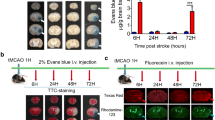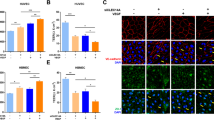Abstract
Stroke induces blood-brain barrier (BBB) breakdown, which promotes complications like oedema and hemorrhagic transformation. Administration of recombinant tissue plasminogen activator (rtPA) within a therapeutic time window of 4.5 h after stroke onset constitutes the only existing treatment. Beyond this time window, rtPA worsens BBB breakdown. Canonical Wnt pathway induces BBB formation and maturation during ontogeny. We hypothesized that the pathway is required to maintain BBB functions after stroke; thus, its activation might improve rtPA therapy. Therefore, we first assessed pathway activity in the brain of mice subjected to transient middle cerebral artery occlusion (MCAo). Next, we evaluated the effect of pathway deactivation early after stroke onset on BBB functions. Finally, we assessed the impact of pathway activation on BBB breakdown associated to delayed administration of rtPA. Our results show that pathway activity is induced predominately in endothelial cells early after ischemic stroke. Early deactivation of the pathway using a potent inhibitor, XAV939, aggravates BBB breakdown and increases hemorrhagic transformation incidence. On the other hand, pathway activation using a potent activator, 6-bromoindirubin-3′-oxime (6-BIO), reduces the incidence of hemorrhagic transformation associated to delayed rtPA administration by attenuating BBB breakdown via promotion of tight junction formation and repressing endothelial basal permeability independently of rtPA proteolytic activity. BBB preservation upon pathway activation limited the deleterious effects of delayed rtPA administration. Our study demonstrates that activation of the canonical Wnt pathway constitutes a clinically relevant strategy to extend the therapeutic time window of rtPA by attenuating BBB breakdown via regulation of BBB-specific mechanisms.








Similar content being viewed by others
References
Dirnagl U (2012) Pathobiology of injury after stroke: the neurovascular unit and beyond. Ann N Y Acad Sci 1268:21–25. https://doi.org/10.1111/j.1749-6632.2012.06691.x
Hanley DF, Awad IA, Vespa PM, Martin NA, Zuccarello M (2013) Hemorrhagic stroke: introduction. Stroke 44:S65–S66. https://doi.org/10.1161/STROKEAHA.113.000856
Hermann DM, ElAli A (2012) The abluminal endothelial membrane in neurovascular remodeling in health and disease. Sci Signal 5:re4. https://doi.org/10.1126/scisignal.2002886
ElAli A, Hermann DM (2010) Apolipoprotein E controls ATP-binding cassette transporters in the ischemic brain. Sci Signal 3:ra72. https://doi.org/10.1126/scisignal.2001213
Sandoval KE, Witt KA (2008) Blood-brain barrier tight junction permeability and ischemic stroke. Neurobiol Dis 32:200–219. https://doi.org/10.1016/j.nbd.2008.08.005
Brouns R, Wauters A, De Surgeloose D, Marien P, De Deyn PP (2011) Biochemical markers for blood-brain barrier dysfunction in acute ischemic stroke correlate with evolution and outcome. Eur Neurol 65:23–31. https://doi.org/10.1159/000321965
Garbuzova-Davis S, Haller E, Williams SN, Haim ED, Tajiri N, Hernandez-Ontiveros DG, Frisina-Deyo A, Boffeli SM et al (2014) Compromised blood-brain barrier competence in remote brain areas in ischemic stroke rats at the chronic stage. J Comp Neurol 522:3120–3137. https://doi.org/10.1002/cne.23582
Lo EH (2008) A new penumbra: transitioning from injury into repair after stroke. Nat Med 14:497–500. https://doi.org/10.1038/nm1735
Wang X, Tsuji K, Lee SR, Ning M, Furie KL, Buchan AM, Lo EH (2004) Mechanisms of hemorrhagic transformation after tissue plasminogen activator reperfusion therapy for ischemic stroke. Stroke 35:2726–2730. https://doi.org/10.1161/01.STR.0000143219.16695.af
Del Zoppo GJ, Saver JL, Jauch EC, Adams HP Jr, American Heart Association Stroke C (2009) Expansion of the time window for treatment of acute ischemic stroke with intravenous tissue plasminogen activator: a science advisory from the American Heart Association/American Stroke Association. Stroke 40:2945–2948. https://doi.org/10.1161/STROKEAHA.109.192535
Sussman ES, Connolly ES Jr (2013) Hemorrhagic transformation: a review of the rate of hemorrhage in the major clinical trials of acute ischemic stroke. Front Neurol 4:69. doi: https://doi.org/10.3389/fneur.2013.00069
Zhang J, Yang Y, Sun H, Xing Y (2014) Hemorrhagic transformation after cerebral infarction: current concepts and challenges. Ann Transl Med 2(81). https://doi.org/10.3978/j.issn.2305-5839.2014.08.08
Clevers H, Nusse,R (2012) Wnt/beta-catenin signaling and disease. Cell 149:1192–1205. doi: https://doi.org/10.1016/j.cell.2012.05.012
Liebner S, Corada M, Bangsow T, Babbage J, Taddei A, Czupalla CJ, Reis M, Felici A et al (2008) Wnt/beta-catenin signaling controls development of the blood-brain. J Cell Biol 183:409–417. https://doi.org/10.1083/jcb.200806024
Tran KA, Zhang X, Predescu D, Huang X, Machado RF, Gothert JR, Malik AB, Valyi-Nagy T et al (2016) Endothelial beta-catenin signaling is required for maintaining adult blood-brain barrier integrity and central nervous system homeostasis. Circulation 133:177–186. https://doi.org/10.1161/CIRCULATIONAHA.115.015982
Lengfeld JE, Lutz SE, Smith JR, Diaconu C, Scott C, Kofman SB, Choi C, Walsh CM et al (2017) Endothelial Wnt/beta-catenin signaling reduces immune cell infiltration in multiple sclerosis. Proc Natl Acad Sci U S A 114:E1168–E1177. https://doi.org/10.1073/pnas.1609905114
ElAli A, Urrutia A, Rubio-Araiz A, Hernandez-Jimenez M, Colado MI, Doeppner TR, Hermann DM (2012) Apolipoprotein-E controls adenosine triphosphate-binding cassette transporters ABCB1 and ABCC1 on cerebral microvessels after methamphetamine intoxication. Stroke 43:1647–1653. https://doi.org/10.1161/STROKEAHA.111.648923
Wang YZ, Yamagami T, Gan Q, Wang Y, Zhao T, Hamad S, Lott P, Schnittke N et al (2011) Canonical Wnt signaling promotes the proliferation and neurogenesis of peripheral olfactory stem cells during postnatal development and adult regeneration. J Cell Sci 124:1553–1563. https://doi.org/10.1242/jcs.080580
Zhao Y, Wei ZZ, Zhang JY, Zhang Y, Won S, Sun J, Yu SP, Li J et al (2017) GSK-3β inhibition induced neuroprotection, regeneration, and functional recovery after intracerebral hemorrhagic stroke. Cell Transplant 26:395–407. https://doi.org/10.3727/096368916X694364
Jean LeBlanc N, Guruswamy R, ElAli A (2018) Vascular endothelial growth factor isoform-B stimulates neurovascular repair after ischemic stroke by promoting the function of pericytes via vascular endothelial growth factor receptor-1. Mol Neurobiol 55:3611–3626. https://doi.org/10.1007/s12035-017-0478-6
Ben-Zvi A, Lacoste B, Kur E, Andreone BJ, Mayshar Y, Yan H, Gu C (2014) Mfsd2a is critical for the formation and function of the blood-brain barrier. Nature 509:507–511. https://doi.org/10.1038/nature13324
Reese TS, Karnovsky MJ (1967) Fine structural localization of a blood-brain barrier to exogenous peroxidase. J Cell Biol 34:207–217
ElAli A, Doeppner TR, Zechariah A, Hermann DM (2011) Increased blood-brain barrier permeability and brain edema after focal cerebral ischemia induced by hyperlipidemia: role of lipid peroxidation and calpain-1/2, matrix metalloproteinase-2/9, and RhoA overactivation. Stroke 42:3238–3244. https://doi.org/10.1161/STROKEAHA.111.615559
Bordeleau M, ElAli A, Rivest S (2016) Severe chronic cerebral hypoperfusion induces microglial dysfunction leading to memory loss in APPswe/PS1 mice. Oncotarget 7:11864–11880. https://doi.org/10.18632/oncotarget.7689
ElAli A, Bordeleau M, Thériault P, Filali M, Lampron A, Rivest S (2016) Tissue-plasminogen activator attenuates Alzheimer’s disease-related pathology development in APPswe/PS1 mice. Neuropsychopharmacology. 41:1297–1307. https://doi.org/10.1038/npp.2015.279
Brown RC, Morris AP, O’Neil RG (2007) Tight junction protein expression and barrier properties of immortalized mouse brain microvessel endothelial cells. Brain Res 1130:17–30. https://doi.org/10.1016/j.brainres.2006.10.083
Taddei A, Giampietro C, Conti A, Orsenigo F, Breviario F, Pirazzoli V, Potente M, Daly C et al (2008) Endothelial adherens junctions control tight junctions by VE-cadherin-mediated upregulation of claudin-5. Nat Cell Biol 10:923–934. https://doi.org/10.1038/ncb1752
Li VS, Ng SS, Boersema PJ, Low TY, Karthaus WR, Gerlach JP, Mohammed S, Heck AJ et al (2012) Wnt signaling through inhibition of beta-catenin degradation in an intact Axin1 complex. Cell 149:1245–1256. https://doi.org/10.1016/j.cell.2012.05.002
Benchenane K, Berezowski V, Fernández-Monreal M, Brillault J, Valable S, Dehouck MP, Cecchelli R, Vivien D et al (2005) Oxygen glucose deprivation switches the transport of tPA across the blood-brain barrier from an LRP-dependent to an increased LRP-independent process. Stroke 36:1065–1070
Abu Fanne R, Nassar T, Yarovoi S, Rayan A, Lamensdorf I, Karakoveski M, Vadim P, Jammal M et al (2010) Blood-brain barrier permeability and tPA-mediated neurotoxicity. Neuropharmacology. 58:972–980. https://doi.org/10.1016/j.neuropharm.2009.12.017.
Hawkins BT, Davis TP (2005) The blood-brain barrier/neurovascular unit in health and disease. Pharmacol Rev 57:173–185. https://doi.org/10.1124/pr.57.2.4
Cramer SC, Chopp M (2000) Recovery recapitulates ontogeny. Trends Neurosci 23:265–271
Knecht T, Story J, Liu J, Davis W, Borlongan CV, Dela Pena IC (2017) Adjunctive therapy approaches for ischemic stroke: innovations to expand time window of treatment. Int J Mol Sci 18:E2756. https://doi.org/10.3390/ijms18122756
Larrue V, von Kumme R, Del Zoppo G, Bluhmki E (1997) Hemorrhagic transformation in acute ischemic stroke. Potential contributing factors in the European Cooperative Acute Stroke Study. Stroke 28:957–960
Zhao BQ, Wang S, Kim HY, Storrie H, Rosen BR, Mooney DJ, Wang X, Lo EH (2006) Role of matrix metalloproteinases in delayed cortical responses after stroke. Nat Med 12:441–445. https://doi.org/10.1038/nm1387
Wang W, Li M, Wang Y, Wang Z, Zhang W, Guan F, Chen Q, Wang J (2017) GSK-3beta as a target for protection against transient cerebral ischemia. Int J Med Sci 14:333–339. https://doi.org/10.7150/ijms
Carson-Walter EB, Hampton J, Shue E, Geynisman DM, Pillai PK, Sathanoori R, Madden SL, Hamilton R et al (2005) Plasmalemmal vesicle associated protein-1 is a novel marker implicated in brain tumor angiogenesis. Clin Cancer Res 11:7643–7650. https://doi.org/10.1158/1078-0432.CCR-05-1099
Shue EH, Carson-Walter EB, Liu Y, Winans BN, Ali ZS, Chen J, Walter KA (2008) Plasmalemmal vesicle associated protein-1 (PV-1) is a marker of blood-brain barrier disruption in rodent models. BMC Neurosci 9:29. https://doi.org/10.1186/1471-2202-9-29
Wang YF, Tsirka SE, Strickland S, Stieg PE, Soriano SG, Lipton SA (1998) Tissue plasminogen activator (tPA) increases neuronal damage after focal cerebral ischemia in wild-type and tPA-deficient mice. Nat Med 4:228–231
Wang W, Li M, Wang Y, Li Q, Deng G, Wan J, Yang Q, Chen Q et al (2016) GSK-3beta inhibitor TWS119 attenuates rtPA-induced hemorrhagic transformation and activates the Wnt/beta-catenin signaling pathway after acute ischemic stroke in rats. Mol Neurobiol 53:7028–7036. https://doi.org/10.1007/s12035-015-9607-2
Soeteman DI, Menzies NA, Pandya A (2017) Would a large tPA trial for those 4.5 to 6.0 hours from stroke onset be good value for information? Value Health 20:894–901. https://doi.org/10.1016/j.jval.2017.03.004
Acknowledgements
We would like to thank Mrs. Revathy Guruswamy for performing some of the MCAo surgeries, Dr. Nathalie Vernoux for preparing the brain samples for TEM, and Mrs. Julie-Christine Lévesque at the Bio-Imaging Platform of CRCHU de Québec for technical assistance.
Funding
This study was financially supported by grants from the Natural Sciences and Engineering Research Council of Canada (NSERC), Heart and Stroke Foundation of Canada (HSFC), and Fonds de recherche du Québec - Santé (FRQS) (all to AEA). NJL was supported by a scholarship from the NSERC, and a scholarship from the Fondation du CHU de Québec. KP was supported by a scholarship from the Fondation du CHU de Québec. MET is a Canada Research Chair (Tier 2) in Neuroimmune Plasticity in Health and Therapy.
Author information
Authors and Affiliations
Corresponding author
Ethics declarations
Animal experiments were performed according to the Canadian Council on Animal Care guidelines, as administered by the Université Laval Animal Welfare Committee.
Conflict of Interest
The authors declare that they have no conflict of interest.
Additional information
Publisher’s Note
Springer Nature remains neutral with regard to jurisdictional claims in published maps and institutional affiliations.
Rights and permissions
About this article
Cite this article
Jean LeBlanc, N., Menet, R., Picard, K. et al. Canonical Wnt Pathway Maintains Blood-Brain Barrier Integrity upon Ischemic Stroke and Its Activation Ameliorates Tissue Plasminogen Activator Therapy. Mol Neurobiol 56, 6521–6538 (2019). https://doi.org/10.1007/s12035-019-1539-9
Received:
Accepted:
Published:
Issue Date:
DOI: https://doi.org/10.1007/s12035-019-1539-9




